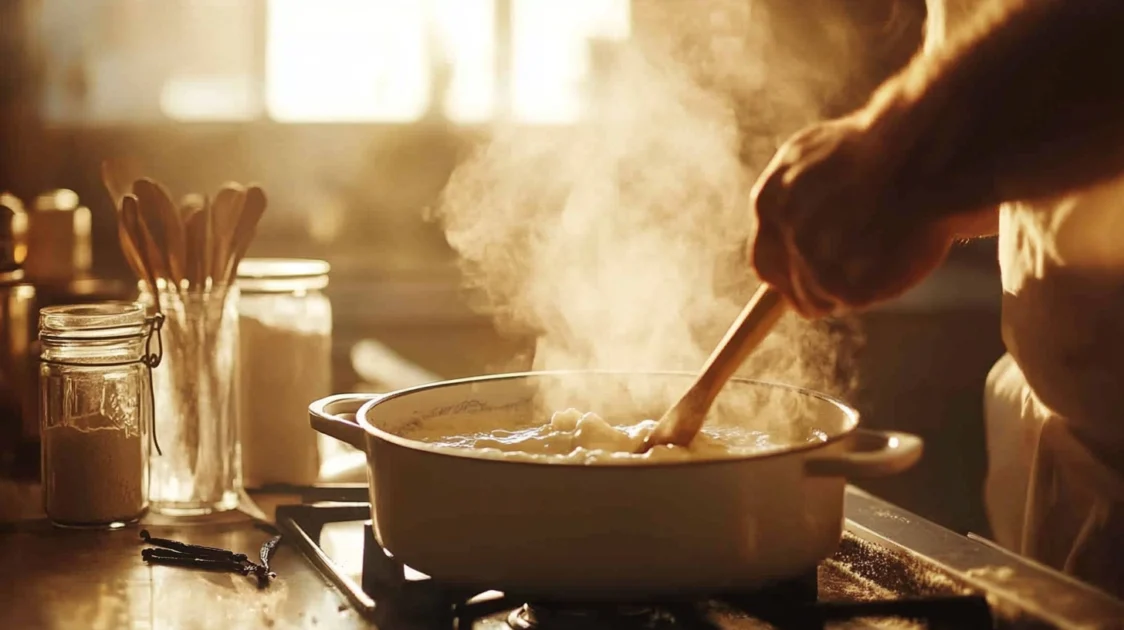Introduction
How do you thicken custard for ice cream? Thickening custard for ice cream is a fundamental skill for creating rich, creamy, and velvety frozen desserts. Achieving the ideal consistency can seem tricky, but with the right techniques and a bit of patience, it becomes an enjoyable process. The key lies in understanding the role of each ingredient, maintaining proper heat control, and using tried-and-true methods for perfect results.
From using egg yolks and cornstarch to experimenting with alternative thickeners like gelatin and xanthan gum, each approach brings its unique benefits. This guide will cover everything you need to know about thickening custard for ice cream, ensuring your desserts are always smooth and satisfying.
Whether you’re crafting classic vanilla or infusing bold new flavors, mastering the art of custard thickness is the foundation of an exceptional ice cream experience. Read on to discover the secrets to elevating your custard game and creating desserts everyone will adore.
Table of Contents

What Is Custard-Based Ice Cream?
Custard-based ice cream is a luxurious frozen dessert that combines the richness of cream, milk, egg yolks, and sugar to create a velvety texture. Unlike non-custard varieties, this type of ice cream incorporates a cooked custard base, which enhances the smoothness and adds depth to the flavor. The process involves heating the mixture gently until the proteins in the egg yolks thicken it to the desired consistency. This step is vital for developing the base that transforms into creamy ice cream once churned and frozen.
The hallmark of custard-based ice cream lies in its perfectly balanced structure. By carefully crafting the custard, you prevent issues such as ice crystal formation or grainy textures. Additionally, this base acts as a canvas for a variety of flavor infusions, from classic vanilla to more adventurous combinations like lavender or dark chocolate. How do you thicken custard for ice cream? That’s the critical question this guide will address.
Why Thickness Matters in Custard for Ice Cream
The thickness of the custard is the foundation of excellent ice cream. A custard that’s too thin can result in a watery, icy dessert, while one that’s overly thick can hinder proper churning. The ideal consistency strikes a delicate balance, allowing the custard to churn into a luscious, creamy ice cream without compromising its structure.
Thickness also plays a crucial role in enhancing the mouthfeel and preventing ice crystals from forming during freezing. A well-thickened custard creates a stable emulsion, blending fat, water, and air to ensure a silky texture. Additionally, the custard’s thickness impacts how flavors are carried to your palate, making it an essential step for a full-bodied taste experience. Understanding how do you thicken custard for ice cream involves mastering the techniques that achieve this ideal texture without over-complicating the process.
Common Issues When Making Custard for Ice Cream
Even seasoned cooks can encounter problems when preparing custard for ice cream. One of the most common issues is a thin custard, often caused by undercooking or incorrect ingredient ratios. This leads to a base that lacks the structure necessary for proper churning and freezing.
On the flip side, overcooking can result in a curdled or scrambled custard, which is challenging to salvage. Uneven heating is another culprit, causing portions of the mixture to cook faster than others. Additionally, improperly tempering the egg yolks can result in lumps forming in the custard.
Another challenge is achieving the right balance of richness and lightness. Too much cream can overpower the texture, while insufficient fat can lead to a watery consistency. Addressing these pitfalls helps answer the key question: How do you thicken custard for ice cream?
Techniques to Thicken Custard for Ice Cream
Achieving the perfect custard thickness requires precision and patience. A variety of methods can help ensure your custard reaches the desired consistency. These techniques focus on ingredient selection, heat control, and careful observation.
- Stir constantly: This prevents lumps and promotes even thickening.
- Use the napé test: Coat the back of a spoon with custard and swipe your finger through it. If it leaves a clear trail, the custard is ready.
- Invest in a thermometer: Cook the mixture to approximately 170–175°F (77–80°C) to allow the egg yolks to thicken without scrambling.
The core of how do you thicken custard for ice cream lies in understanding the interaction of ingredients and heat, ensuring the custard thickens smoothly and evenly.
Using Cornstarch or Other Starches
Cornstarch is a popular solution for thickening custard, particularly if you need extra stability. Its ability to absorb liquid and swell when heated makes it an effective thickening agent. To use cornstarch, mix it with a small amount of cold milk to create a slurry before adding it to the custard mixture.
Other starches, such as arrowroot or tapioca, can also be used, although they may impart a slightly different texture. Here’s how to use cornstarch effectively:
- Measure accurately: Use 1 tablespoon of cornstarch per 1 cup of liquid for a moderately thick custard.
- Cook properly: Ensure the mixture reaches a boil to activate the starch’s thickening properties.
- Avoid over-stirring: Over-mixing can break down the starch, reducing its effectiveness.
Adding cornstarch to the custard base is a reliable way to answer the question, how do you thicken custard for ice cream?
Egg Yolks: The Natural Thickener
Egg yolks are the traditional thickening agent in custard, providing both structure and richness. They work by coagulating when heated, binding the custard’s ingredients together. However, using egg yolks requires careful technique to avoid curdling.
To incorporate egg yolks successfully:
- Temper carefully: Slowly whisk hot liquid into the yolks to gradually raise their temperature before combining with the rest of the mixture.
- Monitor heat closely: Cook the custard over low to medium heat, stirring constantly to prevent overheating.
- Use fresh eggs: Fresher eggs coagulate more effectively, contributing to a smoother custard.
Mastering the use of egg yolks is central to understanding how do you thicken custard for ice cream. Their natural properties not only thicken but also enrich the flavor profile of your dessert.
Cream and Milk Adjustments
The balance of cream and milk in your recipe significantly affects the thickness of the custard. Adjusting the fat content in the base can help achieve a more stable texture. Heavy cream adds richness and viscosity, while milk ensures the mixture doesn’t become overly dense.
Tips for optimal adjustments:
- Experiment with ratios: A typical starting point is 1 cup of cream to 1 cup of milk, but you can tweak this based on your preferences.
- Consider alternative dairies: For a lighter custard, try using half-and-half or whole milk alone.
- Heat gently: Higher fat content requires careful temperature control to prevent splitting.
Adjusting these elements is an essential step in answering the pivotal question, how do you thicken custard for ice cream?
Low-Heat Cooking: Patience Is Key
Low and slow cooking is the golden rule when thickening custard for ice cream. Applying gentle heat allows the proteins in the egg yolks to coagulate evenly, creating a silky texture without lumps or curdling.
Steps to follow:
- Use a double boiler: This setup reduces the risk of overheating by applying indirect heat.
- Stir continuously: Prevents the custard from sticking to the pan and ensures even thickening.
- Be patient: Rushing this process often leads to an uneven or under-thickened base.
When asked, how do you thicken custard for ice cream?, patience is often the most critical part of the answer. By allowing the custard to cook gradually, you ensure a flawless texture that’s ready for freezing.
Alternative Thickeners for Custard
When exploring how do you thicken custard for ice cream, alternative thickeners can be incredibly useful, especially if you want to customize the texture or adapt to dietary preferences. While traditional methods rely on egg yolks or cornstarch, other options such as gelatin, agar-agar, or xanthan gum can provide unique benefits. These thickeners can enhance the custard’s stability, making it suitable for different applications or dietary restrictions.
- Gelatin creates a soft, creamy texture, ideal for custard-based ice creams.
- Agar-agar, derived from seaweed, offers a vegan-friendly alternative.
- Xanthan gum is a versatile thickener used in small amounts for precise control.
Choosing the right thickener depends on the desired outcome and your recipe’s requirements, helping you navigate the question of how do you thicken custard for ice cream with creative solutions.
Gelatin and Agar-Agar: Setting Agents
Gelatin and agar-agar offer fantastic solutions for thickening custard, providing structure and stability that enhance the creamy consistency of ice cream. Derived from collagen, gelatin works by forming a gel-like network as it cools, creating a smooth texture. This process results in a silky custard that’s perfect for freezing and churning.
Agar-agar, on the other hand, is plant-based and perfect for vegan or vegetarian recipes. It thickens at higher temperatures than gelatin and creates a firmer texture.
Using Gelatin:
- Dissolve gelatin in a small amount of cold water before adding it to the warm custard.
- Avoid overheating, which can weaken its setting properties.
Using Agar-Agar:
- Simmer agar-agar in liquid until fully dissolved before incorporating it into the custard.
Both options provide an effective way to answer how do you thicken custard for ice cream, particularly when dietary considerations come into play.
Xanthan Gum: Modern Innovations in Custard Making
Xanthan gum, a modern thickening agent, offers precision and control when addressing how do you thicken custard for ice cream. This polysaccharide, often used in professional kitchens, thickens liquids effectively at low concentrations without the need for heat. It stabilizes emulsions and prevents ice crystals, making it a valuable addition to custard-based ice creams.
Advantages of xanthan gum include:
- Ease of use: A tiny amount (¼ teaspoon per cup) thickens effectively.
- Heat stability: Works without altering the flavor or requiring high temperatures.
- Versatility: Suitable for gluten-free and vegan recipes.
To use xanthan gum, sprinkle it evenly into the custard while blending to avoid clumping. It’s an innovative solution that simplifies how do you thicken custard for ice cream while delivering consistent results.
Step-by-Step Guide to Perfect Custard Thickness
Mastering how do you thicken custard for ice cream begins with a clear, methodical approach. Follow these steps to achieve the perfect custard base:
- Gather Ingredients: Use fresh milk, cream, egg yolks, sugar, and your chosen thickener.
- Heat Gradually: Warm the milk and cream mixture over low heat, stirring constantly.
- Temper the Yolks: Slowly whisk a portion of the warm mixture into the yolks, then combine everything.
- Cook Carefully: Return the mixture to the stove, cooking over low heat until it thickens.
- Test Consistency: Use the napé test—if the custard coats the back of a spoon and leaves a clear trail, it’s ready.
- Cool Promptly: Strain the custard into a clean bowl and chill it thoroughly before churning.
By following these steps, you’ll confidently handle the challenge of how do you thicken custard for ice cream with ease.
Pro Tips for Perfect Ice Cream Custard Every Time
Consistency and flavor go hand-in-hand when perfecting custard for ice cream. Here are expert tips for ensuring success every time you tackle how do you thicken custard for ice cream:
- Use a thermometer: Keep the temperature below 180°F to prevent curdling.
- Choose quality ingredients: High-fat cream and fresh eggs create a richer custard.
- Strain the mixture: Remove lumps or bits of cooked egg for a smooth finish.
- Infuse flavors early: Add vanilla beans, citrus zest, or spices to the milk while warming for a balanced taste.
- Chill thoroughly: Cooling the custard before churning enhances texture and prevents ice crystals.
These tips ensure your custard base is flawless, answering the question how do you thicken custard for ice cream with professional-level finesse.
FAQs About Thickening Custard for Ice Cream
How to increase the thickness of custard?
To increase the thickness of custard, adjust the balance of ingredients or use additional thickening agents. Egg yolks, cornstarch, or other starches are traditional options. Begin by tempering the egg yolks with warm liquid to prevent curdling, then cook the custard over low heat, stirring constantly until it thickens. If the custard remains too thin, mix a slurry of cornstarch and cold milk and slowly incorporate it into the custard while heating. Low-heat cooking and patience are essential to achieving the desired thickness without lumps.
How thick should ice cream custard be?
Ice cream custard should have a consistency similar to heavy cream or a loose pudding before freezing. It should coat the back of a spoon, leaving a clear trail when you swipe your finger through it (this is known as the napé stage). The custard should not be overly thick, as it needs to churn smoothly in the ice cream maker. A custard that’s too thin can result in an icy texture, while one that’s too thick can freeze unevenly.
Can you put custard in an ice cream maker?
Yes, custard is the ideal base for making ice cream in an ice cream maker. Once the custard is cooked to the desired thickness, it should be cooled thoroughly in the refrigerator before churning. Proper cooling helps the custard set and improves the final texture of the ice cream. Ensure the custard is not too thick, as it must churn easily to incorporate air and achieve a creamy consistency.
What ingredient is used to thicken custard?
The primary ingredient used to thicken custard is egg yolks. Their proteins coagulate when heated, binding the custard’s components together. Other common thickening agents include cornstarch, which adds stability, or alternative options like gelatin and agar-agar for specific textures. The choice of thickener depends on the recipe and desired outcome. A combination of egg yolks and cornstarch is often used for optimal thickness and a silky texture.
What is the difference between ice cream base and custard base?
How to make custard vs ice cream?
Conclusion: Mastering Custard Thickness for Ice Cream
Achieving the perfect custard thickness is both an art and a science. Whether you rely on traditional egg yolks, cornstarch, or alternative thickeners like gelatin, understanding how do you thicken custard for ice cream is key to creating an exceptional frozen dessert. With the right techniques and attention to detail, you’ll consistently produce ice cream that’s creamy, flavorful, and satisfying. By integrating these methods into your process, you’ll master the craft of custard-based ice cream, ensuring every batch is a delicious success.


